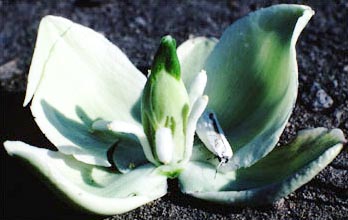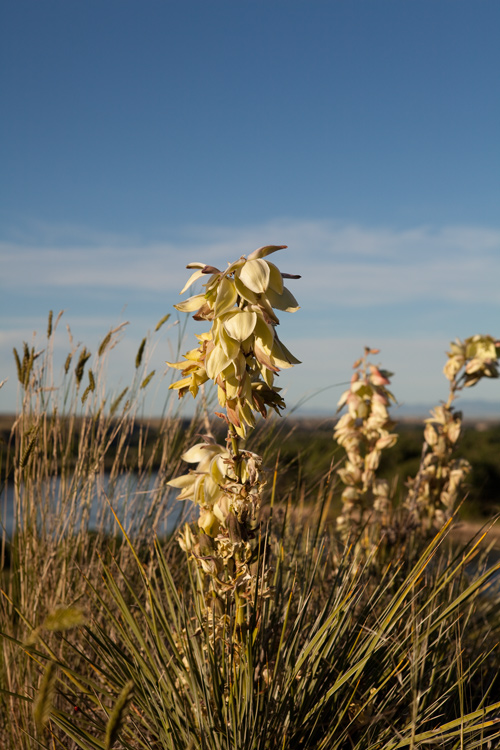Yucca and Moth
On the heat of the day, yucca blossoms close their petals and hang their heads. At night they open upward to welcome the ministrations of a little white moth of the Pronuba genus whose own life is inextricably linked with that of the plant.[1]Pronuba is a Latin epithet for the goddess Juno, who presided over marriages. Yucca pollen is heavy and sticky, so it can’t be scattered by wind or by casual contact with other insects. The mother moth tucks a ball of pollen under her chin, flies to another flower, pierces an ovary wall, and deposits an egg inside. She then crawls in with it and forces the little ball of pollen into the top of the stigma. The pollen fertilizes the yucca ovules, propagating tiny seeds that serve as baby-food for the moth’s grubby offspring, which proceed to eat their way out of the Yucca seed pod.
Surely Lewis and Clark would have been fascinated by the symbiosis of the yucca and the moth, could they have but observed it. They would have appreciated the practical uses of this sturdy desert resident, too. Indians and Euro-American pioneers derived an effective soap from its root. Thus another common name for it is soapweed. Medicinally, the root was used to treat upset stomach, arthritis, inflammation from bruises, sprains, and bone fractures, and to reduce hair loss. Today, herbalists use it as an anti-inflammatory. The flowers, flower stalks, and seed pods are edible if properly cooked.
Nuttall’s 1813 Description
Flowering Yucca at Decision Point
Yucca glauca
© 28 June 2013 by Kristopher K. Townsend. Permission to use granted under the Creative Commons Attribution-Share Alike 4.0 International license.
None of the expedition’s journalists made any note of yucca, although in writing of Lemhi Shoshone Indian dress, Meriwether Lewis mentioned “a small cord of the silk-grass” which at least one scholar has interpreted as referring to the yucca. Indeed, many Indian peoples pounded the hard leaves to loosen the fibers, which were twisted into thread, the sharp point serving as a needle. It may be that Lewis preserved a specimen, but it was lost or damaged before it could be sent back east.
For the scientific world, Yucca glauca was not officially “discovered” until 1811 when the English naturalists Thomas Nuttall and John Bradbury ascended the Missouri River with competing fur companies in search of new botanical treasures. Nuttall named this new species in an ephemeral catalogue (published in October 1813) of new seeds available at the Fraser Brothers Nursery in Chelsea, England, “for curious American plants.” Nuttall had managed to leave New Orleans just before the outbreak of the 1812 war between England and the United States; Bradbury was prevented from sailing for several months, although his collection of plants made it to England in early 1812.
Frederick Pursh, the same Saxon botanist who examined the Lewis and Clark collection, gained access to the Bradbury specimens and published several of the new species in the appendix to his Flora Americae septentrionalis (published in late December 1813). Pursh also named the small soapweed, calling it Yucca angustifolia. By virtue of “priority” (the botanist who first published the binomial and description), Nuttall’s name is the one used today.
History
Glauca is the Latin word for “greenish-grey.” The yucca plant is common to hot, dry, gravelly habitats throughout the West. Its cream-colored, bell-shaped flowers attest to its membership in the lily family. The Dakota Indian name for it is Hupestula; Omahas and Poncas call it Duwaduwa-hi; Pawnees know it as Chakida-kahtsuor Chakila-kahtsu. Its needle-sharp leaves have given it the common name “Spanish bayonet.”
Notes
| ↑1 | Pronuba is a Latin epithet for the goddess Juno, who presided over marriages. |
|---|
Experience the Lewis and Clark Trail
The Lewis and Clark Trail Experience—our sister site at lewisandclark.travel—connects the world to people and places on the Lewis and Clark Trail.
Discover More
- The Lewis and Clark Expedition: Day by Day by Gary E. Moulton (University of Nebraska Press, 2018). The story in prose, 14 May 1804–23 September 1806.
- The Lewis and Clark Journals: An American Epic of Discovery (abridged) by Gary E. Moulton (University of Nebraska Press, 2003). Selected journal excerpts, 14 May 1804–23 September 1806.
- The Lewis and Clark Journals. by Gary E. Moulton (University of Nebraska Press, 1983–2001). The complete story in 13 volumes.



